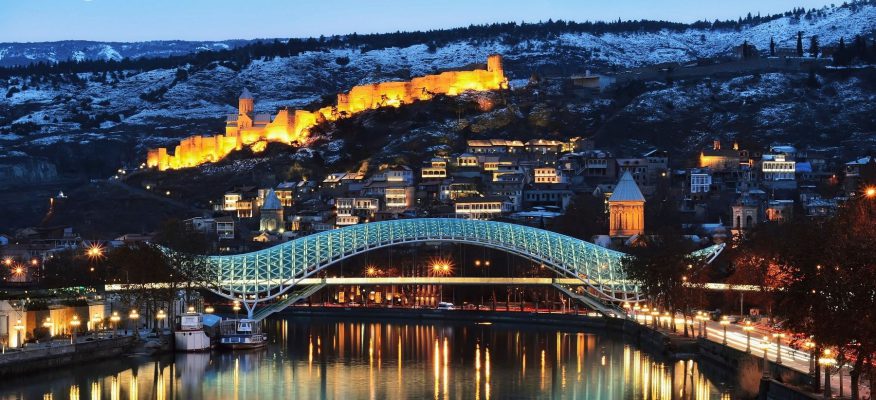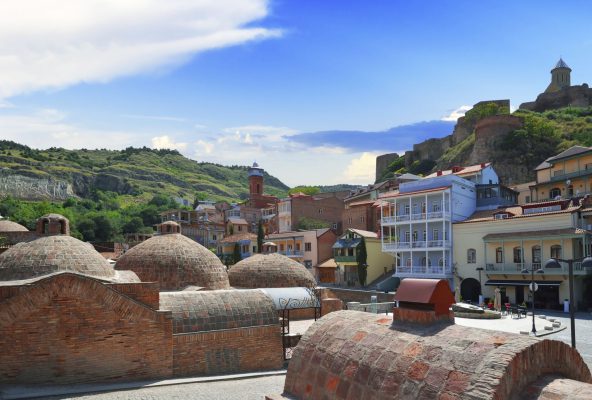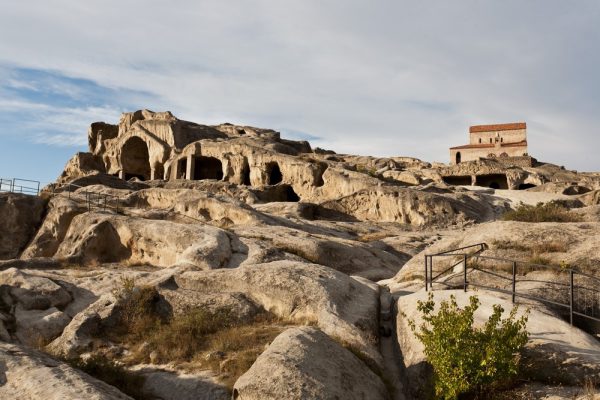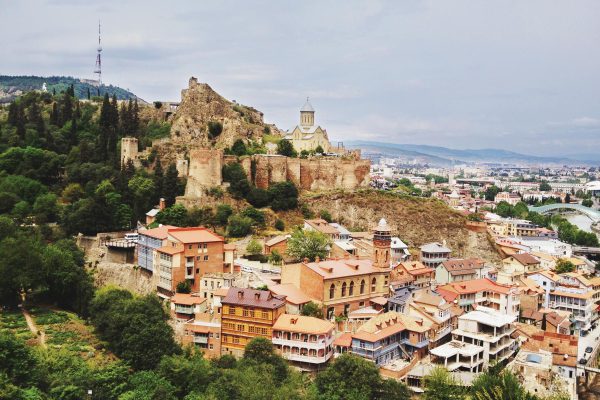On Saturday, 23rd September 2023, a group of 19 friends embarked on a remarkable journey to Georgia, a country known for its rich history, vibrant culture, and exquisite landscapes. Organized by the Georgian-Dutch tour company Tika Tours and warmly greeted by David, we were guided by Ia Gebrandze, making our Georgian adventure truly unforgettable.
We checked in at the Astoria Tbilisi Hotel and then, within walking distance, rode the Mtatsminda cable car to Restaurant Funicular atop the mountain. The cable car ascent provided a breathtaking view of the old city of Tbilisi. From the Funicular Restaurant, we enjoyed a spectacular panoramic view of the illuminated city and the Trinity Cathedral. The restaurant is renowned, and we all relished a delightful meal paired with Georgian wines, including the Mtsvane and Saperavi varieties.
On Sunday, our guide Ia led us through the city of Tbilisi, a place that has been inhabited over the centuries by Persians, Tatars, Jews, and Armenians. The heart of the Georgian capital boasts an intriguing array of architectural styles. Tbilisi has a population of 1,500,000 inhabitants (with the total population of Georgia being only 4,500,000). Ia guided us through the old town with its picturesque pedestrian streets, abundant restaurants, traditional houses adorned with grapevines, finely carved wooden balconies from the 17th-18th centuries and artistic places. Our visit included the Anchiskhati Church, the oldest church founded in the 6th century and rebuilt several times, notably in 1675. The present frescoes date back to the 18th century, and within the church, we were treated to the beautiful singing of a men’s choir.
Erekle II Street, a charming pedestrian street featuring trendy bars, art galleries, and terraces, led us to the Peace Bridge, a bow-shaped pedestrian bridge that opened in 2010, symbolizing Georgia’s transition from the past to a brighter future. Designed by the Italian architect Michele de Lucchi, the modern bridge spans 150 meters and is illuminated with numerous LEDs. It is one of the capital’s landmarks.
Continuing our exploration, we visited Sionis Street, where the Sioni Cathedral is located. The original church dates back to the 7th century, and the present structure is from the 12th century. The cathedral is the focal point of religious life in the city, housing St. Nino’s Cross from 337 AD, crafted by binding two vine branches together with her own hair. We also explored the Tbileli or Carvasla caravanserai, built in 1650, rebuilt in 1820, and then in 1912 with an Art Nouveau façade, now housing the Museum of History of Tbilisi. Opposite the caravanserai stands a sculpture of Tamada, the toast master with the horn.
Next, we visited the Metheki Church of the 4th century overlooking the city, next to the equestrian statue of King Gorgasali, the city’s founder. Taking a cable car to the top of the Sololaki hill, we admired a large statue of the Mother of Georgia next to the Narikala fortress, erected in 1958 during Tbilisi’s 1500th-anniversary celebration. Designed by the Georgian sculptor Elguja Amashukeli, the 20-meter-high figure symbolizes the Georgian national character. In her left hand, she holds a bowl of wine for welcoming friends, and in her right hand, a sword for those who come as enemies. The statue is a significant symbol of Georgian culture and heritage, representing the strength and hospitality of the country.
Descending the mountain along the Botanic Gardens, we reached the area of bathhouses, with the Chreli Baths, a striking 17th-century bathhouse with a Persian façade of bright blue tiles resembling a mosque. Most bathhouses are situated underground. We had lunch at the Marani restaurant, where a delicious Georgian meal with Saperavi wine was served. Following lunch, we participated in a calligraphy workshop, receiving our names in calligraphic characters on paper. Our exploration continued with a visit to the National Museum on Rustaveli Street, where we admired artifacts from 3000 BC, golden objects from 800-300 BC, and a plethora of gold and carnelian jewelry. The Art Museum houses the Treasury of gold- and silverware.
Our day concluded with dinner at the Ethno Tsiskvili restaurant outside the center, where we indulged in an assortment of Georgian dishes, bread, and wines. An orchestra performed traditional folk music and dances.
On Monday, we left Tbilisi and made a stop in Gori, the birthplace of Stalin in 1879. From the outside, we had a view of Stalin’s small house, consisting of just one room where he lived until the age of 4. Next to the museum, a train wagon was displayed, which Stalin used for travel to places like Tehran, Yalta, and Potsdam, as he had a fear of flying. In front of the house stands a giant (17 m high) Stalin statue, one of the rare statues still preserved. In Gori, Stalin is still honored as a hero, despite his controversial legacy.
Uplistsikhe, located in eastern Georgia, is an abandoned rock-hewn town that played a significant role in Georgian history. Founded in the late Bronze Age around 1000 BC, it continued to be inhabited until the 13th century AD. Uplistsikhe served as one of the most important political and religious centers of pre-Christian Kartli, a predecessor of the Georgian state. The city, carved into the slopes of the Mtkvari valley, features rock-cut structures such as Tamaris Darbazi (a large hall), pagan places of sacrifice, dwellings, and functional buildings like a pharmacy, bakery, temple, prison, and an amphitheatre named after Queen Tamar.
En route to Kutaisi, we passed through a dry landscape with manganese mines, ceramics factories, and a zone of grey, dusty metallurgical factories, most of which are now closed. Kutaisi is the capital of the Kolcheti region, and we stayed at the Best Western Hotel.
On Tuesday, we explored the old center of Kutaisi, starting at the bridge over the Rioni River. The bridge itself features engraved poems from 19th-century poets. We then visited the Main Square with a giant fountain, the theatre, opera, and charming old buildings surrounded by a park with sculptures. Our tour included the Bagrati Cathedral on Ukimerioni Hill, surrounded by the remains of a 6th-century fortress. We also visited the Archeological Museum in Vani. Vani was the major center from the 8th to the 1st century BC and many of the finest artefacts from ancient Colchis region were found here. Still excavations are going on this region. In the 6th century BC gold jewelry was buried with nobles, together with the ceramics. There is a display of weapons and tools, beautiful gold ornaments, silver coins, qvevris, art objects and a statue of Tamada with the horn. We admired a fantastic collection.
Lunch took place at Gia Mkheidze Winery in Vani. We had a wine tasting near the qvevris (amphorae) in the cellar and enjoyed a lavish lunch with Georgian salad, eggplant salad, bread, and grilled meat. The owner, acting as the toastmaster or “tamada,” conducted a wine toasting ceremony using two horns, a unique Georgian tradition.
Georgia is the only country in the world where wine is kept in clay vessels called “Qvevri.” This ancient winemaking and storage method is inscribed on the UNESCO list of cultural treasures, and Georgia is the birthplace of wine, with winemaking dating back around 8000 years.
Continuing our journey to Borjomi, we passed the Surami fortress in a region marked by manganese mines. The Borjomi-Kharagauli National Park, located in the central part of the Caucasus, is recognized for its outstanding biodiversity and is listed as one of the 35 priority ecoregions by the Worldwide Fund for Nature.
In the Borjomi health resort, we stayed at the Hotel Borjomi Palace, an old-style Grand hotel with luxurious rooms. We took a stroll through the park, exploring historical sulfur baths and experiencing the healing properties of the mineral waters in the Borjomi valley. The baths, built in the 1st century AD, feature warm water springs with a sulfur taste, where people can drink from the source, and cold-water springs where water is bottled and exported abroad. We also admired the 19th-century residence mansion “Firuza” at the entrance, built in light-blue Persian Islamic architecture.
On Wednesday, we left the village and by bus, we passed the old houses of the Russian elite along the Borjomi river through a mountain landscape. We visited the Jvary Monastery, built in the 6th century AD, situated on a cliff overlooking the confluence of the Mtkvari and Aragvi rivers. The monastery is located where Nino first set up her cross, overlooking the pagan shrines of Mtskheta. Inside, we saw the massive plinth of St. Nino’s Cross and a wooden iconostasis. The country’s conversion to Christianity occurred in Mtskheta in 337 AD making it one of Georgia’s most important religious centers. On the highway to Tsinandali, where we stayed at the Park Hotel, we could see the distant Caucasus mountains with snow at 5000 m high.
On Thursday, we visited the Chavchavadze Museum, a large and elegant mansion belonging to Alexander Chavchavadze. He was a distinguished Georgian poet and general, often referred to as the father of Georgian Romanticism and the first practitioner of European winemaking in Georgia. The museum, situated in a beautiful park, houses rooms adorned with old paintings and classical furniture. Later, we drove to the city of Telavi, a charming town in the heart of the Kakheti wine region, featuring a fortress and a statue of King Erekle near a 900-year-old plane tree.
Our next destination was the Khareba Winery Estate in Kvareli, where we enjoyed a delightful lunch in the estate’s scenic park, followed by a wine tasting experience in the underground caves. The winery boasts a 7 km tunnel housing vintage wines dating back to 1840, and we sampled three types of wine, with a special focus on the amber wines aged in qvevris. The estate also showcased traditional winemaking techniques. Moving on, we visited the Cathedral of St. George in Alaverdi, located 20 km from Telavi. The church, built in the 11th century from tuff stone and surrounded by defensive walls added in the early 18th century, underwent thorough renovation in 2010. We witnessed people bringing roosters as offerings to the monastery next to the cathedral. The monastery, founded in the 6th century by Syrian monks, has a traditional winery dating back to the 11th century, preserving knowledge of traditional techniques even during the Soviet period. A guided tour at the Qvevri Wine Museum provided insights into winemaking processes, grape varieties, and the significance of qvevris. The wines, stored in clay amphoras, are exported to Europe. After a delightful dinner at the museum’s restaurant, we headed to the Park Hotel in Tsinandali, within the Kakheti region.
On Friday, en route to Signagi, we marveled at the breathtaking mountain landscapes and stunning views of the Alazani Valley, renowned as the birthplace of Georgian wines. Along the road, walnut and hazelnut trees were observed, with their nuts being used by the Ferrero Rocher chocolate factory.
Signagi, a small town with a rich history, sits on a hill enclosed by a fortified wall, considered the second-longest wall after the Great Wall of China. The town, chosen for renovation by President Saakashvili to attract tourists, features a wedding hall emulating Las Vegas ceremonies, a theatre, beautifully restored houses, and various architectural monuments. The park houses a wall commemorating Georgian soldiers lost in World War II.
Our lunch at Chateau Svanidze, estate Mashnari owned by Tika Svanidze Vancko, unfolded in a picturesque estate with orchards filled with various fruit trees. The terrace hosted a demonstration of traditional Georgian cuisine preparation, including bread for the fireplace, churchkela (mixture of walnuts and grapes), mtsvadi (Georgian barbecue), khinkali (meat dumplings), khachapuri (Georgian cheese pie), and caramel-coated walnuts. Amidst a tasteful lunch by the swimming pool, we relished Georgian salads, eggplant salads, oven-baked bread, grilled meat, dumplings, and rosé and amber wines, creating a delightful ambiance in a splendid setting.
Post-lunch, we traveled to Tbilisi, where some explored the old part of the city or traditional bathhouses, while others visited the Eliava Institute of Bacteriophages. The Eliava Institute, founded in 1923 by Georgian microbiologist George Eliava and Canadian scientist Felix D‘Herelle, is a globally renowned center focusing on bacteriophage research and developing phage preparations for human and animal protection. The institute collaborates with scientific centers worldwide, emphasizing the isolation and selection of bacteriophages against antibiotic-resistant bacterial strains.
Following the visit, we checked into the Astoria Hotel in Tbilisi and enjoyed dinner at the rooftop restaurant of the Golden Tulip Hotel, offering a splendid view of the illuminated city. Despite a brief night, we departed for Amsterdam by plane.
All participants expressed immense satisfaction with their journey through Georgia, praising the country’s culture, cuisine, wines, and our knowledgeable guide, Ia Gebrandze. Our trip left an indelible mark on the hearts of the participants, revealing the beauty and warmth of Georgia.
Special thanks to Tika Svanidze Vancko, owner of Tika Tours, for organizing the trip. Before our departure, Tika conducted an informative meeting and a wine tasting of her Georgian wines www.tikawine.com. For more info, visit www.tikatours.com.
Gratitude is also extended to the Ambassador of Georgia, H.E. David Salomonia, who supported the trip and hosted a reception for all participants. The event included a presentation of highlights and a Georgian wine tasting at his Residence.
Written by Nanda Jagusiak-Monteiro



